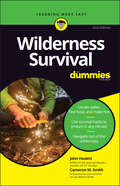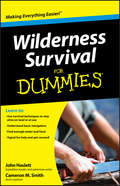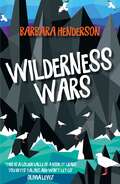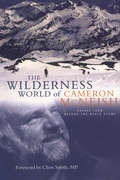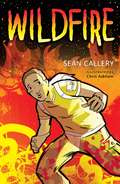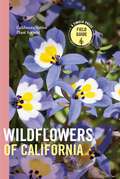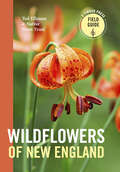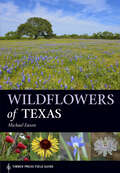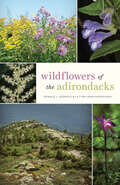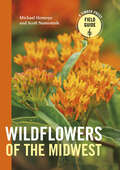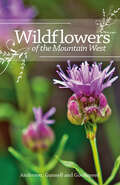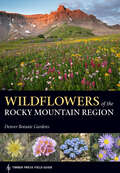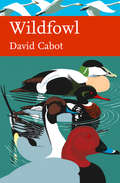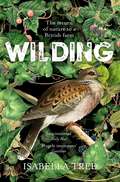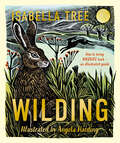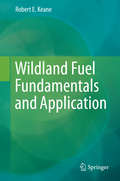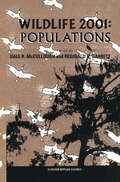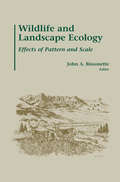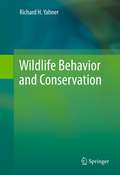- Table View
- List View
Wilderness Survival For Dummies
by John F. Haslett Cameron M. SmithBe prepared for anything, so you can explore where others fear to tread Wilderness Survival For Dummies takes a practical approach to teaching you the skills you need to stay alive outside. Learn survival skills the Dummies way, with helpful diagrams and illustrations, step-by-step instructions, and tips from the pros. With expert tips and easy-to-follow instructions in this book, you’ll know what to do to survive in the wild. Stay calm, deal with the elements, make fire, find drinking water, and navigate your way to safety, thanks to your newfound survival skills. Enjoy the great outdoors with the confidence to take the path less traveled Gain knowledge that will help you stay safe if the unexpected happens Deal with extreme weather events, make shelter, learn to signal for help Learn navigation skills so you can find your way home if you get lostYou’re ready to take your love of nature to the next level and explore the wilderness. From forests and jungles to deserts, cold weather climates, and everything in between, you need this Dummies guide to stay safe while backpacking, sailing, camping, and adventuring …wherever.
Wilderness Survival For Dummies
by Cameron M. Smith John F. HaslettLearn to: Use survival techniques to stay alive on land or at sea Understand basic navigation Find enough water and food Signal for help and get rescued Your one-stop guide to surviving and enjoying the Great Outdoors Want to know how to stay alive in extreme situations? This practical, accurate guide gives you all the expert, field-tested tools and techniques you need to survive. Whether you find yourself lost in the woods, adrift on a life raft, bitten by a snake, or needing shelter in cold weather, this hands-on resource teaches you how to stay safe (and sane), find rescue, and live to tell the tale! Know the basics of survival — perform life-saving first aid, make fire and shelter, and find water and food Manage your emotions — cope with panic and anger, get the "survivor's attitude," and foster cooperation and hope with others Increase your chances of rescue — signal for help and navigate using a compass or the sky Practice expert survival methods — tie essential knots, craft your own weapons and tools, and make natural remedies Gain wisdom for water emergencies — stay afloat when your ship or boat sinks, avoid dehydration and starvation, and make it to shore Open the book and find: Common survival scenarios you may encounter Tried-and-tested advice for individuals or groups The items you need to stay alive Basic orientation skills Ways to keep warm or cool The best methods for building a fire in any environment What you can (and can't) eat and drink in the wild True stories of survival
Wilderness Survival For Dummies
by Cameron M. Smith John F. HaslettLearn to: Use survival techniques to stay alive on land or at sea Understand basic navigation Find enough water and food Signal for help and get rescued Your one-stop guide to surviving and enjoying the Great Outdoors Want to know how to stay alive in extreme situations? This practical, accurate guide gives you all the expert, field-tested tools and techniques you need to survive. Whether you find yourself lost in the woods, adrift on a life raft, bitten by a snake, or needing shelter in cold weather, this hands-on resource teaches you how to stay safe (and sane), find rescue, and live to tell the tale! Know the basics of survival — perform life-saving first aid, make fire and shelter, and find water and food Manage your emotions — cope with panic and anger, get the "survivor's attitude," and foster cooperation and hope with others Increase your chances of rescue — signal for help and navigate using a compass or the sky Practice expert survival methods — tie essential knots, craft your own weapons and tools, and make natural remedies Gain wisdom for water emergencies — stay afloat when your ship or boat sinks, avoid dehydration and starvation, and make it to shore Open the book and find: Common survival scenarios you may encounter Tried-and-tested advice for individuals or groups The items you need to stay alive Basic orientation skills Ways to keep warm or cool The best methods for building a fire in any environment What you can (and can't) eat and drink in the wild True stories of survival
Wilderness Wars
by Barbara HendersonWhat if nature fights back? In a daze, I take it all in: the wind, the leaden skies, the churning moody sea. And, far in the distance, a misty outline. Skelsay. Wilderness haven. Building-site. Luxury-retreat-to-be. And now, home. When her father’s construction work takes Em’s family to the uninhabited island of Skelsay, she is excited, but also a little uneasy. Soon Em and her friend Zac realise that the setbacks, mishaps and accidents on the island point to something altogether more sinister: the wilderness all around them has declared war. Danger lurks everywhere. But can Em and Zac persuade the adults to believe it before it’s too late?
Wilderness World of Cameron McNeish: Essays From Beyond The Black Stump
by Cameron McNeishCameron McNeish is one of Scotland's best-known hillwalkers and broadcasts regularly on national radio and television. He considers himself an "evangelist" for the wild places of the world - mountains, deserts, remote coastlines and forests - anywhere that lies beyond the black stump. Having walked, climbed, ski'd and backpacked throughout the world, he now takes the reader on a journey through the its wild places, from the Cairngorms to Yosemite. The book includes a series of essays on McNeish's native Scotland which define those elements that make wilderness so special and worth protecting.
Wildfire (High/Low)
by Sean CallerySol tries to fit in with Kyle and his gang but he never seems to get it right. When Sol ends up in a group with them for the summer expedition he is worried about fitting in but it turns out he should have been worried about something else. In the blazing heat, things take a dangerous turn. Can Sol convince anyone to listen to him or will the expedition end in disaster?Highly readable, exciting books that take the struggle out of reading, Wired encourages and supports reading practice by providing gripping, age-appropriate stories for struggling and reluctant readers and those with English as an additional language aged 11+, at a manageable length (64 pages) and reading level (9+). Produced in association with reading experts at CatchUp, a charity which aims to address underachievement caused by literacy and numeracy difficulties.
Wildfire (High/Low)
by Sean CallerySol tries to fit in with Kyle and his gang but he never seems to get it right. When Sol ends up in a group with them for the summer expedition he is worried about fitting in but it turns out he should have been worried about something else. In the blazing heat, things take a dangerous turn. Can Sol convince anyone to listen to him or will the expedition end in disaster?Bloomsbury High Low books encourage and support reading practice by providing gripping, age-appropriate stories for struggling and reluctant readers, those with dyslexia, or those with English as an additional language. Printed on tinted paper and with a dyslexia friendly font, Wildfire is aimed at readers aged 11+ and has a manageable length (80 pages) and reading age (9+).Produced in association with reading experts at CatchUp, a charity which aims to address underachievement caused by literacy and numeracy difficulties.
Wildflower Wonders: The 50 Best Wildflower Sites in the World
by Bob GibbonsFrom the Mojave Desert in the USA to the Italian Dolomites, and from South Africa's Cape National Park to the Stirling Ranges of Australia, this book showcases the most spectacular displays of wild blooms on the planet.Each site account begins with a locator map and info panel detailing timing, key species etc. This is followed by an informative and readable account by the expert author (who has personally visited nearly all of the sites covered) accompanied by a handful of stunning images of each location showing off the displays of flowers.In addition there are chapters on the animal life that can be found at these sites, and on the conservation status of the locations covered in the book.Many people travel widely in search of spectacular displays of flowers, but are guided only by word-of-mouth information, or by what organised tours are available. This book sets out to rectify this gap. However, it aims to be much more: the most 'flowery' places in the world are exceptionally spectacular at their best, and the beautiful photography in the book allows a broad audience to enjoy these sights without even leaving the house.
Wildflowers of California
by California Native Plant SocietyExperience the vibrant diversity of West Coast Wildflowers with this amazing, informative guide to more than 1,200 plant species.Wildflowers of California is a comprehensive field guide for anyone wishing to learn about the amazingly diverse wildflowers of the region. Organized by flower color and shape, and including a range map for each flower described, the guide is as user-friendly as it is informative. This must-have book is perfect for hikers, naturalists, and native plant enthusiasts. Describes and illustrates 1200 commonly encountered species Includes perennials, annuals, and shrubs, both native and nonnative Thousands of superb color photographs and range maps User-friendly organization by flower color and shape
Wildflowers of New England (A Timber Press Field Guide)
by Ted Elliman Native Plant TrustAs a part of the Timber Press Field Guide book series, Wildflowers of New England is the must-have book for simple, accurate regional flora identification.
Wildflowers of Texas (A Timber Press Field Guide)
by Michael EasonA must-have guide for hikers, naturalists, gardeners, and anyone wishing to learn more about the diverse wildflowers of Texas.
Wildflowers of the Adirondacks
by Lytton Musselman Donald LeopoldCovering more than six million acres of protected wilderness, the Adirondacks, with their landscape of high peaks, verdant wetlands, majestic trees, and lush carpets of flowers, is a pristine paradise for nature lovers. The only available identification guide to the Adirondack region's wildflowers, this comprehensive resource is packed with more than 300 gorgeous color images, one to represent almost every flower commonly found in this huge range. Revealing the stunning diversity of Adirondack wildflowers, from goldenrod and marsh blue violet to cattails and hellebore, the book includes • detailed botanical species accounts, arranged by flower color• images of each flower that highlight key features for easy ID• information about each species' natural history• descriptions of the region's upland, wetland, and aquatic habitats• a special section on the nearly 40 terrestrial orchid species found in the AdirondacksWritten by Donald J. Leopold and Lytton John Musselman, skilled botanists and the foremost authorities on these plants, this superior quality guide will appeal to residents of and visitors to the Adirondacks and northeastern mountains, including wildlife professionals, citizen scientists, backpackers, campers, photographers, bird watchers, artists, and wild food foragers.
Wildflowers of the Adirondacks (PDF)
by Lytton Musselman Donald LeopoldCovering more than six million acres of protected wilderness, the Adirondacks, with their landscape of high peaks, verdant wetlands, majestic trees, and lush carpets of flowers, is a pristine paradise for nature lovers. The only available identification guide to the Adirondack region's wildflowers, this comprehensive resource is packed with more than 300 gorgeous color images, one to represent almost every flower commonly found in this huge range. Revealing the stunning diversity of Adirondack wildflowers, from goldenrod and marsh blue violet to cattails and hellebore, the book includes • detailed botanical species accounts, arranged by flower color• images of each flower that highlight key features for easy ID• information about each species' natural history• descriptions of the region's upland, wetland, and aquatic habitats• a special section on the nearly 40 terrestrial orchid species found in the AdirondacksWritten by Donald J. Leopold and Lytton John Musselman, skilled botanists and the foremost authorities on these plants, this superior quality guide will appeal to residents of and visitors to the Adirondacks and northeastern mountains, including wildlife professionals, citizen scientists, backpackers, campers, photographers, bird watchers, artists, and wild food foragers.
Wildflowers of the Atlantic Southeast (A Timber Press Field Guide)
by Laura Cotterman Damon Waitt Alan WeakleyAn indispensable guide to finding and identifying the wildflowers of the Atlantic Southeast.
Wildflowers of the Midwest (A Timber Press Field Guide)
by Michael Homoya Scott NamestnikIdeal for hikers, foragers, and plant lovers, the Timber Press Field Guides are the perfect tools for loving where you live. Wildflowers of the Midwest is a comprehensive field guide for anyone wishing to learn about the amazingly diverse wildflowers of the region. This must-have book describes and illustrates 1000 commonly encountered species, including perennials, annuals, and shrubs, both native and nonnative. With more than 1,000 superb color photographs and a user-friendly organization by flower color and shape, this is a must-have guide for birders, hikers, foragers, and natural history buffs. Covers Minnesota, Wisconsin, Michigan, Ohio, Indiana, Illinois, Missouri, and Iowa. Describes and illustrates 1,000 commonly encountered species Includes perennials, annuals, and shrubs, both native and nonnative User-friendly organization by flower color and shape
Wildflowers of the Mountain West
by Richard M. Anderson Jerry L. Goodspeed Jay Dee GunnellMany recreational hikers have stopped along the trail to admire a wildflower only to wonder what, exactly, they are looking at. Wildflowers of the Mountain West is a useful field guide that makes flower identification easy for the general outdoor enthusiast. Many available plant guides are too technical or cumbersome for non-specialists to embrace. Covering New Mexico, Colorado, Wyoming, Idaho, Utah, Nevada and Oregon, this book is perfect for the enthusiasts who has little botanical knowledge but would like to know more about the wildflowers they are seeing. Organized by flower color for easy reference, plant records include the common and scientific names, a description of typical characteristics, habitat information and distribution maps, look-alike species, color photographs, and informative commentary. In addition, the book provides a useful introduction to the Mountain West region, along with line drawings to illustrate basic flower parts, shapes, and arrangements; a glossary of common botanical terms; a quick search key; and an index. The book is spiral-bound, making it easy to bring along while hiking, backpacking, or biking, and stunning full color photographs make visual confirmation of flower type simple and straightforward.
Wildflowers of the Rocky Mountain Region (A Timber Press Field Guide)
by Denver Botanic GardensFeaturing more than 1245 stunning color photographs, this comprehensive field guide is the must-have portable reference for the wildflowers the Rocky Mountain Region.
Wildfowl (Collins New Naturalist Library #110)
by David CabotNew Naturalist Wildfowl provides a much-anticipated overview of the fascinating birds that have become icons of our diminishing wilderness areas.
Wilding: The Return of Nature to a British Farm
by Isabella Tree'A passionately personal, robustly argued and uplifting book . . . One of the landmark ecological books of the decade.' Sunday Times 'Books of the Year'In Wilding, Isabella Tree tells the story of the ‘Knepp experiment’, a pioneering rewilding project in West Sussex, using free-roaming grazing animals to create new habitats for wildlife. Part gripping memoir, part fascinating account of the ecology of our countryside, Wilding is, above all, an inspiring story of hope.Forced to accept that intensive farming on the heavy clay of their land at Knepp was economically unsustainable, Isabella Tree and her husband Charlie Burrell made a spectacular leap of faith: they decided to step back and let nature take over. Thanks to the introduction of free-roaming cattle, ponies, pigs and deer – proxies of the large animals that once roamed Britain – the 3,500 acre project has seen extraordinary increases in wildlife numbers and diversity in little over a decade.Extremely rare species, including turtle doves, nightingales, peregrine falcons, lesser spotted woodpeckers and purple emperor butterflies, are now breeding at Knepp, and populations of other species are rocketing. The Burrells’ degraded agricultural land has become a functioning ecosystem again, heaving with life – all by itself.Personal and inspirational, Wilding is an astonishing account of the beauty and strength of nature, when it is given as much freedom as possible.
Wilding: How To Bring Wildlife Back - An Illustrated Guide
by Isabella TreeWilding: How to Bring Wildlife Back - An Illustrated Guide is a stunningly beautiful gift book written by Isabella Tree which tells the story of the Knepp Estate in West Sussex. It is illustrated in full colour with lino prints and watercolours by Angela Harding (A Year Unfolding) and photographs from Knepp.Knepp is now home to some of the rarest and most beautiful creatures in the UK, including nightingales, kingfishers, turtle doves and peregrine falcons, hazel dormice and harvest mice, scarce chaser dragonflies and purple emperor butterflies. The sheer abundance of life is staggering too. When you walk out into the scrubland on an early spring morning the sound of birdsong is so loud it feels like it’s vibrating in your lungs. This is the story of Knepp, and a guide telling you how to bring wildlife back where you live.Includes timelines, an indepth look at rewilding, spotlight features about native animals including species that have returned and thrive - butterflies, bats, owls and beetles. There are accessible in-garden activities to 're-wild' your own spaces and the book encourages you to slow down and observe the natural world around you, understand the connections between species and habitats, and the huge potential for life right on your doorstep.
Wildland Fuel Fundamentals and Applications
by Robert E. KeaneA new era in wildland fuel sciences is now evolving in such a way that fire scientists and managers need a comprehensive understanding of fuels ecology and science to fully understand fire effects and behavior on diverse ecosystem and landscape characteristics. This is a reference book on wildland fuel science; a book that describes fuels and their application in land management. There has never been a comprehensive book on wildland fuels; most wildland fuel information was put into wildland fire science and management books as separate chapters and sections. This book is the first to highlight wildland fuels and treat them as a natural resource rather than a fire behavior input. Moreover, there has never been a comprehensive description of fuels and their ecology, measurement, and description under one reference; most wildland fuel information is scattered across diverse and unrelated venues from combustion science to fire ecology to carbon dynamics. The literature and data for wildland fuel science has never been synthesized into one reference; most studies were done for diverse and unique objectives. This book is the first to link the disparate fields of ecology, wildland fire, and carbon to describe fuel science. This just deals with the science and ecology of wildland fuels, not fuels management. However, since expensive fuel treatments are being planned in fire dominated landscapes across the world to minimize fire damage to people, property and ecosystems, it is incredibly important that people understand wildland fuels to develop more effective fuel management activities.
Wildlife 2001: Populations
by D. R. McCullough R. H. BarrettIn 1984, a conference called Wildlife 2000: Modeling habitat relationships of terrestrial vertebrates, was held at Stanford Sierra Camp at Fallen Leaf Lake in the Sierra Nevada Mountains of California. The conference was well-received, and the published volume (Verner, J. , M. L. Morrison, and C. J. Ralph, editors. 1986. Wildlife 2000: modeling habitat relationships of terrestrial vertebrates, University of Wisconsin Press, Madison, Wisconsin, USA) proved to be a landmark publication that received a book award by The Wildlife Society. Wildlife 2001: populations was a followup conference with emphasis on the other major biological field of wildlife conservation and management, populations. It was held on July 29-31, 1991, at the Oakland Airport Hilton Hotel in Oakland, California, in accordance with our intent that this conference have a much stronger international representation than did Wildlife 2000. The goal of the conference was to bring together an international group of specialists to address the state of the art in wildlife population dynamics, and set the agenda for future research and management on the threshold of the 21st century. The mix of specialists included workers in theoretical, as well as practical, aspects of wildlife conservation and management. Three general sessions covered methods, modelling, and conservation of threatened species.
Wildlife and Landscape Ecology: Effects of Pattern and Scale
by John A. BissonetteWhile the research and management of wildlife has traditionally emphasised studies at smaller scales, it is now acknowledged that larger, landscape-level patterns strongly influence demographic processes in wild animal species. This book is the first to provide the conceptual basis for learning how larger scale patterns and processes can influence the biology and management of wildlife species. It is divided into three sections: Underlying Concepts, Landscape Metrics and Applications and Large Scale Management.
Wildlife Behavior and Conservation
by Richard H. YahnerBegins with in-depth coverage of wildlife behavior concepts as they relate to conservation problems. Topics will focus principally on discussion, critique, and development of behavioral concepts, with particular attention given to published studies on various topics in wildlife behavioral concepts as related to conservation and natural history. He will include an extensive list of references.
Wildlife between Empire and Nation in Twentieth-Century Africa (African Histories and Modernities)
by Jeff SchauerThis book traces the emergence of wildlife policy in colonial eastern and central Africa over the course of a century. Spanning from imperial conquest through the consolidation of colonial rule, the rise of nationalism, and the emergence of neocolonial and neoliberal institutions, this book shows how these fundamental themes of the twentieth century shaped the relationships between humans and animals in what are today Kenya, Tanzania, Uganda, Zambia, and Malawi. A set of key themes emerges—changing administrative forms, militarization, nationalism, science, and a relentlessly broadening constituency for wildlife. Jeff Schauer illuminates how each of these developments were contingent upon the colonial experience, and how they fashioned a web of structures for understanding and governing wildlife in Africa—one which has lasted into the twenty-first century.
